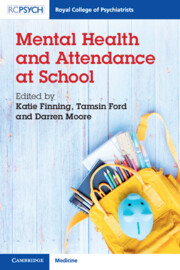Book contents
- Mental Health and Attendance at School
- Mental Health and Attendance at School
- Copyright page
- Contents
- Contributors
- Preface
- Acknowledgements
- Chapter 1 Mental Health and Attendance at School
- Chapter 2 School Attendance
- Chapter 3 Emotional Disorders and Attendance at School
- Chapter 4 Behavioural Disorders and Coping with School
- Chapter 5 Neurodevelopmental Disorders and Attendance at School
- Chapter 6 Educating a ‘New Me’ after an Acquired Brain Injury
- Chapter 7 School Influences on Attendance and Special Educational Needs
- Chapter 8 Supporting the Attendance of Vulnerable Children at School
- Chapter 9 School Attendance and Anxiety
- Chapter 10 Reflections on the Impact of Covid-19 on Children’s Education and Mental Health
- Index
- References
Chapter 6 - Educating a ‘New Me’ after an Acquired Brain Injury
Published online by Cambridge University Press: 24 March 2022
- Mental Health and Attendance at School
- Mental Health and Attendance at School
- Copyright page
- Contents
- Contributors
- Preface
- Acknowledgements
- Chapter 1 Mental Health and Attendance at School
- Chapter 2 School Attendance
- Chapter 3 Emotional Disorders and Attendance at School
- Chapter 4 Behavioural Disorders and Coping with School
- Chapter 5 Neurodevelopmental Disorders and Attendance at School
- Chapter 6 Educating a ‘New Me’ after an Acquired Brain Injury
- Chapter 7 School Influences on Attendance and Special Educational Needs
- Chapter 8 Supporting the Attendance of Vulnerable Children at School
- Chapter 9 School Attendance and Anxiety
- Chapter 10 Reflections on the Impact of Covid-19 on Children’s Education and Mental Health
- Index
- References
Summary
In this chapter we describe the challenges faced by young people who experience an acquired injury to the brain, and explore how this can impact on attendance and engagement with education. The chapter aims to support teachers and other professionals to better understand acquired brain injury (ABI) and the ways in which this sudden, and often evolving, change in needs can affect a child’s education. In the first part of the chapter, we consider the practical challenges to school attendance in the early stages after ABI, and the individual impact on neuropsychological functioning. We go on to describe wider factors within the family, school and educational system that can affect attendance. The second part of this chapter addresses the support needed by young people to make it feasible for them to attend and participate in school life as normally, and successfully, as possible after an ABI. We are enthusiastic about the crucial role played by schools in a child’s rehabilitation after a brain injury, and share practical ideas and principles for maximising their recovery, reintegration and attendance.
Keywords
- Type
- Chapter
- Information
- Mental Health and Attendance at School , pp. 106 - 129Publisher: Cambridge University PressPrint publication year: 2022

